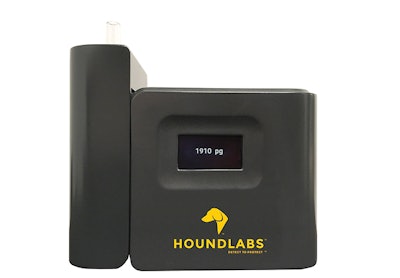 A prototype of Hound Labs' Hound device. The Hound can measure the amount of Tetrahydrocannabinol (THC) present in a person's breath. (Photo: Hound Labs)
A prototype of Hound Labs' Hound device. The Hound can measure the amount of Tetrahydrocannabinol (THC) present in a person's breath. (Photo: Hound Labs)
As a reserve deputy with the Alameda County (CA) Sheriff's Office, Mike Lynn knew his colleagues were frustrated trying to objectively determine which drivers were actually impaired by a substance, particularly marijuana. As an emergency room doctor in Oakland, CA, he has the medical and science background to understand the complexities of measuring small amounts of Tetrahydrocannabinol (THC) that marijuana leaves behind in the bodies of users. So he decided to develop a solution: the Hound.
Lynn, CEO of Hound Labs Inc., co-founded the company to create a product that would allow law enforcement officers to detect the small levels of marijuana that correlate to actual impairment. The key, he says, was measuring THC in the subject's breath.
"The current technology, with a saliva test or urine test or blood test, has the same fundamental limitations: They can't determine whether somebody smoked marijuana five minutes ago or five days ago," says Lynn. This is because a certain amount of THC remains in a person's body for days or even weeks after ingesting marijuana by smoking it or consuming an edible containing the drug.
"From the officer's standpoint, it's difficult determining who needs to be removed from the road [because of impairment] and who just has it in their system. And it's legal to just have it in your system in many states," notes Lynn.
The Hound is completely different in that it measures the amount of THC in a person's breath – which stays there for only a matter of hours at most. "If you're suspicious and you ultimately do the Hound test and it comes up with a measurement for THC, the person must have consumed marijuana within a few hours," Lynn says.
The Hound works very much like an alcohol breath test. In fact, it measures blood alcohol content through breath as well. An officer puts in a new cartridge and a new straw for each subject. Once the subject blows into the straw, the officer inserts the device in a docking station secured in the officer's trunk. In a few minutes, results showing the levels of alcohol and THC appear on the screen of the Hound device.
"Each cartridge comes in an individual sterilized bag and every single test is done with a new cartridge, so we prevent contamination from anyone else's system," says Lynn. "With every test, within the system there's a calibration test. And weather won't affect it." Each used cartridge can then be kept as evidence for future use in court.
An officer might operate the Hound like an alcohol breath test in principle, but the science behind it is much more sophisticated. This is why it's taken so long for Hound Labs' patent-pending technology to be developed. The Hound must detect minute amounts of THC in a measurement called picograms, or parts per trillion. This is compared to just parts per thousand for measuring alcohol in a person's breath. Lynn explains it this way. "It's hard to visualize a picogram. It's looking for 250 specific green grains of sand in multiple Olympic size swimming pools filled with white sand."
It took a long time for alcohol breath testing to be accepted as evidence in court, but Lynn has high hopes for the Hound and Hound Labs' patent pending method of detecting THC in breath. "We think ours will be accepted much more rapidly. We're undergoing the studies right now," says Lynn. "We're providing the tools so that over time the research can be done that correlates an absolute level with driving impairment."
The Hound has been tested by law enforcement officers on the job and is currently in the final stages of product development. For now, Lynn anticipates officers using the Hound for preliminary readings of THC levels to help determine whether to arrest someone posing a danger by being behind the wheel of a vehicle. Lynn says there is no reason the Hound couldn't be used at DUI checkpoints, or anywhere else portable alcohol breath tests are used.
"This gives them the objective data that they need to confirm their suspicions," says Lynn. "We developed the Hound with officers' input every step of the way. When it comes out in the field, they'll find it easy to use and it will help them determine which drivers should be taken off the road and which can be released."


